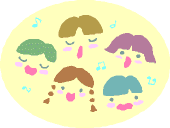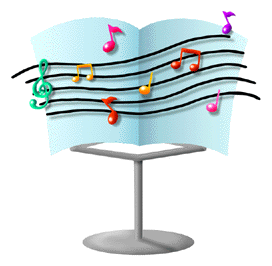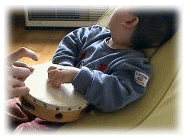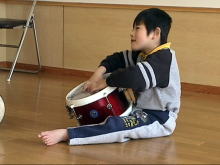






Since there are various methods of musical therapy,
and it changes with the view of practioners (generally called therapists),
it is difficult to declare to one method.
In the Hikari Center, we use psychotherapy. It is practiced
in various countries and there are lots of different types of psychotherapy.. Hikari Center introduce one among those.
A client and a therapist share time and space through music, and while the client has felt music directly and established the human relations borne, that particular music can be used as process in treatment.
Hikari center always focuses on improvement in QOL of our clients, and
the process is physical, mental, and emotional. The process which leads
to the well-being of all our clients is maintained, and it is regarded
as impotant that all our users are considered a unique spiritual domain
whose wholeness and balance needs to be maintained.
Although the concepts of psychotherapy, musical education, speech therapy,
occupational therapy, and physiotherapy all come from various fields,
the Hikari Center is mainly focused on the theory of psychotherapy with
creative musical therapy as a foundation. Three theories have been put
into practice. A Azlow's self-actualization method (develops the possibility
of actualising the potential of each user), C. Rogers client-centered treatment
(one technique of psychotherapy where treatment is focussed on the client
being accepted solely as an individual), and R. Steiner's philosophy of
human relationships, in which "a melody resides in every human being",
shows us more about how to help our users.
It asks for an exchange of the heart, sound and music are used according to the place.. We think that children are conscious of their existence in the child's response to the sounds another child makes. Then, the client and the practitioners try to establish meaningful communication. Trained practitioners care about how to make atmosphere or sounds depending on each client's feelings and emotional state based on the non-verbal cues the client gives out. The assistant also makes sounds to indicate the way he or she feels and responds according to the sounds the client produces, accepting those sounds, and perhaps adding more to them. By experiencing such a mutual relationship, and by being accepted in such a way, this method has the ability to build confidence, and expressive ability is raised and emotional stability is the final aim. We think this is possible by carrying out experiencial expressive feelings, such as a joy, sadness, and anger.
*Communication between assistants and users is improved
*Help users to feel comfortable.
*Users express their feelings to broaden self expressions
He is hearing a keyboard sounds
while playing with the snare drum.
He smiles if the sound suits his motion.
She loves songs! She listens carefully with her all smiles.
Six children have put into practice each 30 minutes individual session 2 times per month. The practice may not carry or finish soon by user’s’ condition at that time.
He scratches the tambourine with therapist. He tells his sounds though the tambourine.